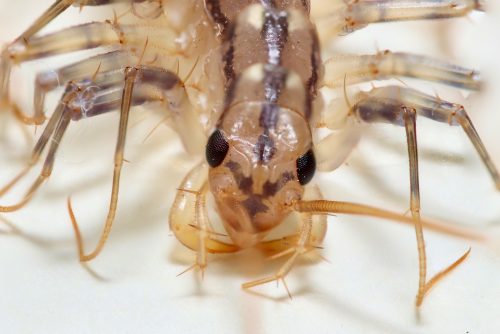Mary caught a centipede in the house, and I was going to take a quick picture of it…but it was way too active. So I had the bright idea of bringing it to the lab, and just carry it outside as I walked in. I had it in a large plastic container that I figured would provide some thermal insulation.
It was not enough.
Before I reached the end of the driveway, it was immobile — that was less than a minute. It took another 3 or 4 minutes to get to work, and it looked dead and frozen. I took a picture anyway. This is a sad, corpselike centipede. Whoops. I was pretty sure I’d killed it with surprising speed. I guess -20°C isn’t healthy for small invertebrates.
And then it started twitching as it warmed up. Now it’s fully recovered. I guess centipedes are harder to kill than I thought.



Just chillin’. I use a stint in the refrigerator to slow down fireflies for photography. Doesn’t take long to warm them up. Scutigera coleoptrata are creepy fast, but they’re great houseguests and eat less desireable arthropods.
That doesn’t surprise me. I’ve seen how arthropods “slow down” in the cold and eventually stop moving without dying. Isn’t that the whole idea behind putting lobsters on ice? Nice to have a happy ending.
My Favourite Microscopist (his official title), Spike Walker, chilled a ruby-tailed wasp he found and imaged it.
I believe that once warmed up again it flew away seemingly happy. I think it placed in one of the Wellcome Image Awards a decade or so ago.
Recently I saw somebody on Twitter post a near identical image; I felt it was a direct copy.
I had thought centipede implies 100 legs. But checking Wikipedia, it says that while centipede species can have a varying number of legs ranging from 30 to 382, there is no centipede with exactly 100 legs since they always have an odd number of pairs. Meanwhile, millipedes only have an even number of pairs of legs. Also, centipedes are mainly carnivores while millipedes are mainly herbivores.
Jeez, now you’ll be trying to raise centipede food.
Also, centipedes glow under black light, like scorpions.
Careful Doc,some people on here will accuse you of posting trivial things while are thoughts and prayers should be with them plucky Ukrainians.
Chortle ,chortle.
This is way,way way off target.Just had an email from Shell energy ,they are the gits that supply my electricity .
Because of the price cap ending in April they are putting their prices up,the bastards.
I sent them an email,and this is what I wrote.
“I think you are taking the piss,and you and all the other energy companies are a bunch of robbing bastards.
I haven’t decided what I am going to do yet,I might stop using my electric cooker and economy 10 heating and get LPG equipment .
Any way ,there is no way I am paying you an extra £666 a year.
So go piss up a rope”.
What do you think,too subtle?
When I was a kid we used to catch wasps and put them in the freezer. When they were immobilized we would quickly and gently tie a thread around the petiole. When it came out of its frozen stupor, we would have a wasp on a leash.
One time we had a wasp flying around in the circle made by the thread. It landed on the thread, started chewing, and a minute later flew away with a segment of thread still attached. It’s like the wasp figured out what the problem was and realized how to rectify the situation.
@imback
If we’re doing centipede facts, they also have the appendages on their second segment specialised as a type of stinger (forcipules). you can see these in PZ’s photo, they are what look like the first legs below the centipedes head.
But would a centipede survive hibernating on LV426?
Centipedes don’t seem to freak me out like wot some spiders do.
Centipedes have 1 pair of legs per body segment while millipedes have 2 pair per segment.
Good myriapoda ( https://en.wikipedia.org/wiki/Myriapoda ) aricle via BBC here on one of that class that really is very leggy indeed – Illacme plenipes :
https://www.bbc.com/news/science-environment-20319140
Then there’s the one true millipede albiet not an exact number and actually excessive – Eumillipes persephone :
https://www.csiro.au/en/news/news-releases/2021/legs-for-days-scientists-discovers-worlds-first-true-millipede-in-western-australia
Plus see this one minute long youtube clip on our leggiest known critter .
Fun fact – a scientist who specialises in millipedes is called a diplopodologist and the the scientific study of millipedes is known as diplopodology. Millipede wikipage though googling for that seems to result in, um, pretty much zilch for that sadly.,Millipede wikipage also notes :
Here in Adelaide, South Oz, we used to have an issue with introduced Portugese millipedes which exploded in plague proportions becoming quite a nusiance when I was growing up. They were rather inoffensive really but absolutely stank when accidentally (often unavoidably) stepped on and got everywhere including into homes and schools and all over railway lines and elsewhere. An issue now largely solved by an introduced nematrode parasitic predator on (& in!) them.